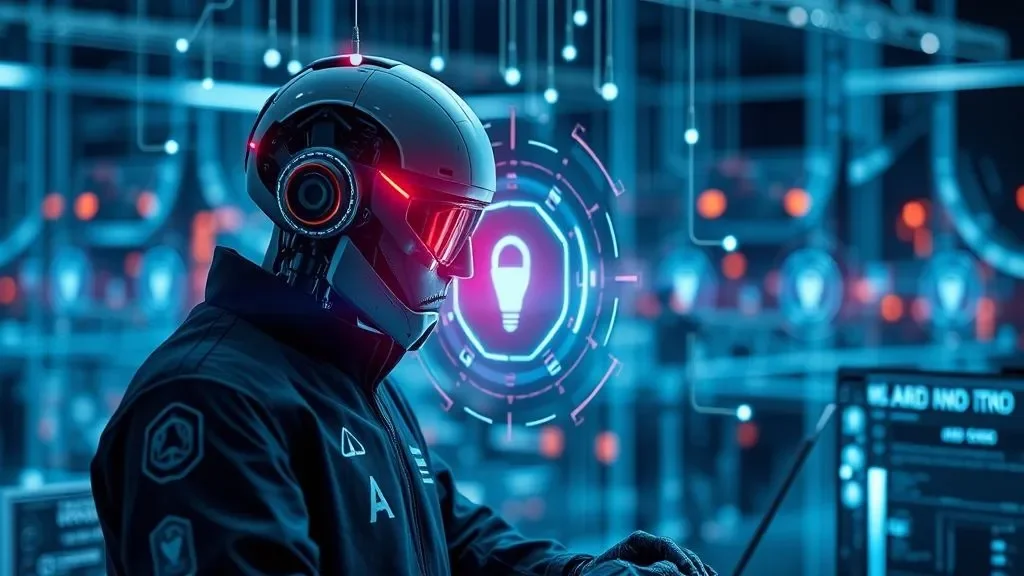In the digital age, voice replication technology has advanced to the point where it can mimic well known figures with stunning accuracy. One of the most talked-about examples is the Trump AI voice, which sounds almost indistinguishable from the former president himself.
This technology has fueled viral content, political satire, and even discussions about its impact on media and communication. Whether used for entertainment or more serious applications, the ability to generate a Donald Trump AI voice raises both excitement and ethical concerns.
With the growing popularity of Trump voice AI, many are curious about how it works, its potential applications, and whether it can be misused. As more tools make this technology widely accessible, questions about its future and implications continue to arise.
For Those Who Don’t Know
The Trump AI voice refers to a digitally replicated version of Donald Trump’s voice, generated through advanced speech synthesis technology. It captures his distinct tone, speech patterns, and mannerisms, making it sound almost identical to real recordings.
This technology enables users to create customized audio clips, where any text can be converted into a Donald Trump AI voice. Whether for humor, commentary, or content creation, its ability to imitate a well-known public figure has made it highly popular online.
As this technology continues to evolve, it’s important to understand how it works, the platforms that offer it, and the ethical implications of using a Trump AI voice generator in different contexts.
How Does Trump AI Voice Actually Work?
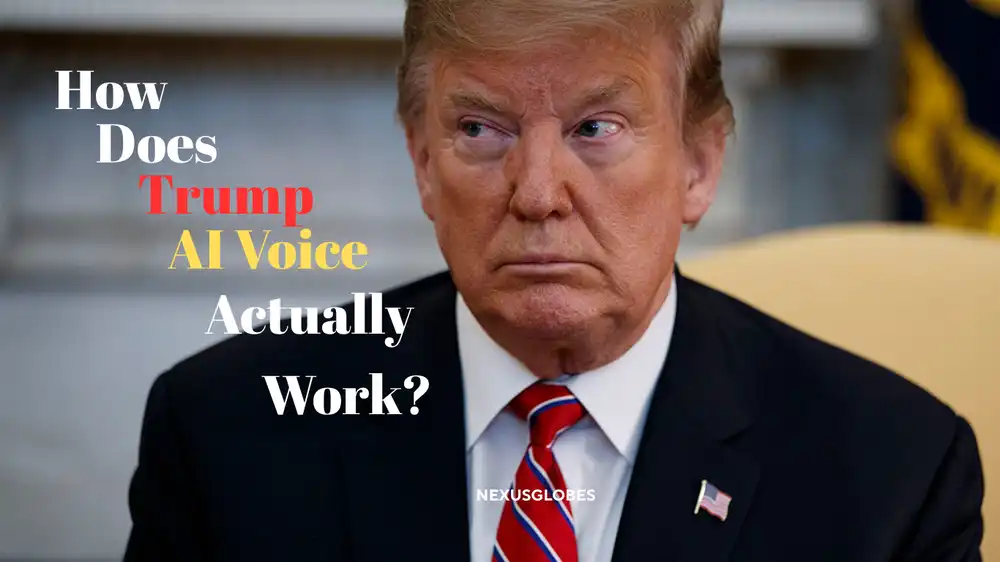
The Trump AI voice is created using advanced speech processing techniques that analyze and replicate Donald Trump’s voice patterns. These systems break down audio recordings into small segments, capturing details like pitch, tone, and rhythm. By training on a vast amount of voice data, they can generate highly accurate speech that mimics his unique speaking style.
A Trump AI voice generator allows users to input text, which is then converted into speech that sounds nearly identical to real-life recordings. The more data the system has, the more natural and realistic the output becomes. This is why newer tools continue to improve their accuracy, making the difference between real and AI-generated voices harder to detect.
With growing demand, many platforms now offer Trump voice AI services, making it easy for anyone to generate lifelike voice clips. While this has led to fun and creative content, it also raises concerns about potential misuse, such as misleading audio clips or impersonation.
What’s the Tech Behind Trump’s AI Voice?
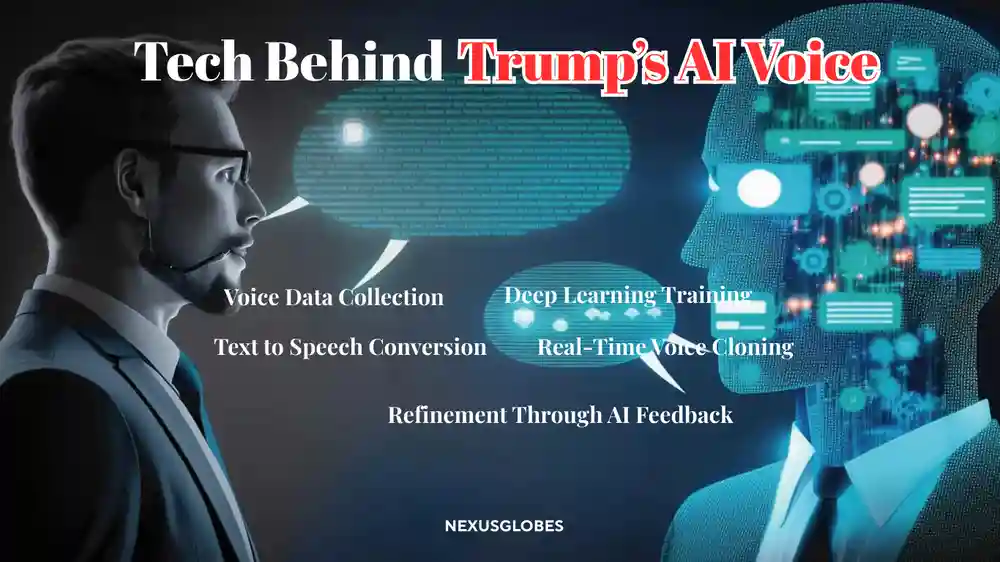
The Trump AI voice isn’t just a simple sound effect it’s built using cutting-edge machine learning and deepfake technology that allows computers to mimic real speech with incredible accuracy. Here’s how it works:
1. Voice Data Collection
To create an AI Trump voice, massive amounts of Donald Trump’s voice recordings are gathered from speeches, interviews, and public appearances. These recordings help train the AI to understand his tone, pronunciation, and signature speaking style.
2. Deep Learning Training
Once enough audio data is collected, the system uses deep neural networks to break down every detail of his speech. It analyzes pitch, rhythm, pauses, and even breathing patterns to make the generated voice sound as natural as possible.
3. Text-to-Speech Conversion
A Trump AI voice generator lets users type any text, which is then processed by the AI and turned into lifelike speech. This is where the system truly shines, as it applies all the learned speech patterns to create a nearly perfect voice clone.
4. Real-Time Voice Cloning
Some advanced Trump AI voice converters can generate speech in real-time, making live conversations or AI-driven voice assistants possible. These tools are evolving rapidly, allowing even more interactive and convincing applications.
5. Refinement Through AI Feedback
The AI continues to improve as it gathers user feedback and refines the voice output. The more data it processes, the more human-like and indistinguishable the AI Trump voice becomes.
This breakthrough technology is why platforms like TryParrotAI, FineShare, and FakeYou are gaining popularity for their ability to create Donald Trump AI voice generators with near-perfect accuracy.
Why Does Trump AI Voice Sound So Real?
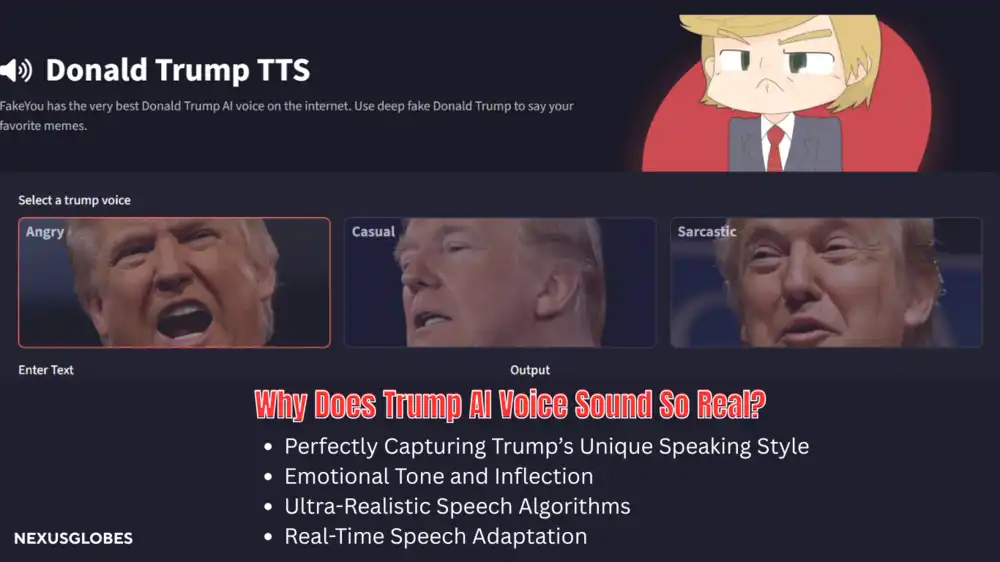
The reason the Trump AI voice sounds so eerily real comes down to a mix of advanced AI modeling, deep learning, and speech synthesis techniques. Let’s break it down:
1. Perfectly Capturing Trump’s Unique Speaking Style
Trump has a distinct way of speaking pauses, emphasis on certain words, hand gestures that influence his tone, and a signature rhythm. AI models are trained to replicate these exact patterns, making the output sound authentic.
2. Emotional Tone and Inflection
Most generic AI voices sound robotic, but a Donald Trump AI voice generator doesn’t just copy words—it mimics emotion, sarcasm, and even Trump’s iconic dramatic delivery. This makes it sound natural and believable.
3. Ultra-Realistic Speech Algorithms
Unlike old-school text-to-speech software, modern Trump voice AI uses deep learning-based voice cloning, where the system listens to thousands of hours of Trump’s real speeches to refine its accuracy.
4. Advanced Sound Processing for Natural Flow
A major reason the AI Trump voice feels so real is that it doesn’t just piece together random words it creates a continuous, natural-sounding flow of speech with no awkward gaps or glitches.
5. High-Quality Audio Samples for Maximum Authenticity
Platforms like TryParrotAI, FineShare, and FakeYou use studio-quality recordings to enhance the clarity and richness of the Donald Trump AI voice text-to-speech output. This eliminates distortions, making the voice even more realistic.
6. Real-Time Speech Adaptation
Some Trump AI voice converters even allow for live voice transformation, meaning you can speak into a mic, and the AI will instantly convert your voice into Trump’s signature sound.
With these advancements, the AI Donald Trump voice is becoming increasingly difficult to distinguish from the real thing. This has led to both exciting possibilities and serious concerns about how this technology could be used.
Where Is Trump AI Voice Being Used?
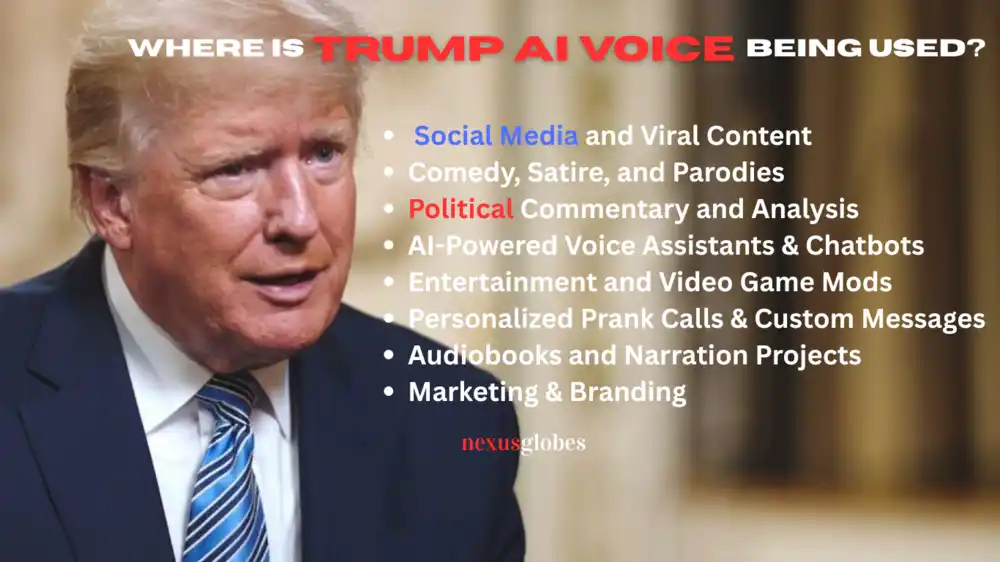
The Trump AI voice isn’t just a novelty it’s being used in multiple industries and platforms, from entertainment to marketing. Here are some of the most common ways people are leveraging this technology:
1. Social Media and Viral Content
Creators are using Donald Trump AI voice generators to produce hilarious or thought-provoking content for platforms like TikTok, YouTube, and Instagram. From meme-worthy speeches to satirical commentary, these AI-generated clips are racking up millions of views.
2. Comedy, Satire, and Parodies
Late-night shows, content creators, and meme pages are generating Trump’s voice to create fake campaign speeches, interviews, and funny skits. Since Trump has a recognizable and exaggerated way of speaking, AI voice tools make parodies sound even more convincing.
3. Political Commentary and Analysis
Some analysts and journalists use Trump AI voice converters to reenact hypothetical speeches, test political messaging, or demonstrate the risks of AI-generated misinformation.
4. AI-Powered Voice Assistants & Chatbots
Developers are integrating AI Trump voice into virtual assistants and automated response systems, making them more engaging and humorous. Imagine asking a chatbot a question and receiving a Donald Trump-style response!
5. Entertainment and Video Game Mods
Game modders are adding Trump’s AI-generated voice to popular titles, letting players experience Trump narrating missions, making announcements, or delivering one-liners in video games.
6. Personalized Prank Calls & Custom Messages
People are using Trump AI voice generators to create custom voice messages, birthday greetings, and prank calls, making it sound like Trump is personally addressing someone.
7. Audiobooks and Narration Projects
Some creators experiment with AI Trump voice to read books, speeches, or historical texts in Trump’s voice, creating an amusing and unique listening experience.
8. Marketing & Branding
Brands sometimes use Trump voice AI in ads, promotional videos, and marketing campaigns to grab attention with a familiar and bold voice.
The use of Donald Trump AI voice text-to-speech is expanding, and as tools like TryParrotAI, FineShare, and FakeYou keep improving, the possibilities will only grow. But with this rise in usage, concerns about misuse and ethics are becoming more urgent.
Is Trump AI Voice a Problem?

While the Trump AI voice is entertaining and innovative, it has sparked serious ethical and legal concerns. As this technology becomes more widespread, experts are questioning its potential for misuse and manipulation.
1. Misinformation & Fake News
One of the biggest concerns is the spread of false information. A Donald Trump AI voice generator can be used to create fake political speeches, fabricated interviews, or misleading statements, making it harder for the public to distinguish between real and AI-generated content.
2. Political Manipulation & Deepfakes
Deepfake technology, including AI Trump voice generators, can be used to influence public opinion, sway elections, or create politically charged hoaxes. This raises concerns about how easily AI-generated voices could be used for propaganda or deception.
3. Privacy & Identity Theft Risks
If an AI can clone a person’s voice, it could be used to impersonate them in phone calls, financial scams, or even personal messages. A Trump AI voice converter might be fun for entertainment, but similar technology could be misused for fraudulent activities.
4. No Clear Legal Regulations
Currently, there aren’t strict global laws controlling the use of AI-generated voices, making it difficult to hold creators accountable if the technology is used maliciously. While some platforms ban deceptive AI content, there’s still a lack of enforcement.
5. Ethical Concerns in Entertainment & Media
While AI Trump voice is widely used for humor and parody, some argue it crosses ethical lines especially when deepfake voices are used without consent. There’s a fine line between creative expression and potential harm.
6. Platforms Cracking Down on AI Voice Abuse
As concerns grow, some AI platforms, including TryParrotAI, FineShare, and FakeYou, are implementing safeguards to prevent misuse. However, since AI voice technology is accessible worldwide, bad actors can still find ways to exploit it.
The rise of Donald Trump AI voice free tools makes it easier than ever to create realistic speech clones, but without proper regulations, the risks could outweigh the benefits.
How to Use Trump AI Voice Responsibly
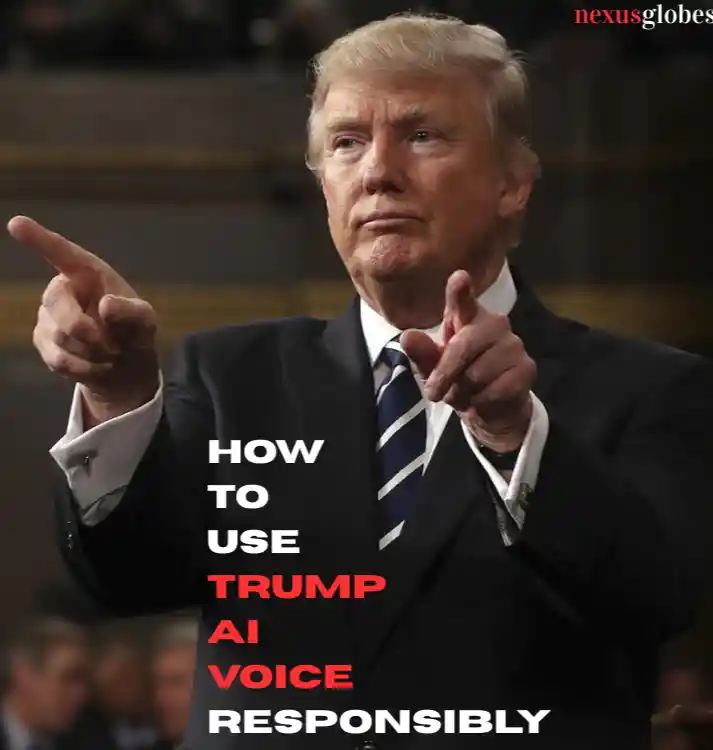
As the Trump AI voice becomes more advanced, using it responsibly and ethically is more important than ever. While this technology unlocks exciting opportunities for creativity, humor, and digital content creation, it also raises concerns about misuse, misinformation, and potential ethical dilemmas.
When used correctly, Trump AI voice generators can add value to entertainment, marketing, and interactive experiences, offering new ways to engage audiences. However, without proper guidelines, it can easily be misused for deception, impersonation, or misleading political content.
Understanding the fine line between creativity and manipulation is key. Whether you’re using AI-generated voices for satire, education, or storytelling, it’s essential to consider the potential impact on audiences, the spread of false information, and the ethical responsibilities that come with this powerful tool.
1. Use It for Entertainment, Not Deception
A Donald Trump AI voice generator can be great for comedy, parodies, and harmless fun, but never use it to spread false information or manipulate audiences. Transparency is key if you’re using an AI-generated voice, make it clear to your audience.
2. Avoid Using It for Fraud or Impersonation
Misusing Trump AI voice converters for scams, fake endorsements, or deceptive activities can have legal consequences. Always ensure that your use of Trump voice AI complies with ethical guidelines and platform policies.
3. Respect Intellectual Property & Consent
Even though public figures like Trump don’t have personal rights over AI-generated versions of their voices, using an AI Trump voice in ways that could damage reputations or mislead people can raise ethical concerns.
4. Choose Reputable AI Voice Platforms
Not all AI voice tools are created equally. Platforms like TryParrotAI, FineShare, and FakeYou have terms of service that restrict harmful usage. Always read the guidelines of AI Donald Trump voice generators before using them.
5. Educate Others About AI Voice Technology
With deepfakes and AI-generated content becoming more convincing, it’s important to educate people about the difference between real and AI-generated voices. Awareness can help prevent misinformation and reduce manipulation.
6. Follow Platform and Social Media Rules
Many social media sites, including YouTube, TikTok, and Twitter (X), are implementing rules against misleading AI content. If you’re posting Trump AI voice-generated content, ensure that it follows platform policies to avoid being flagged or banned.
7. Stay Updated on AI Voice Regulations
Laws regarding AI-generated voices are constantly evolving. Governments and tech companies are working on new policies to prevent abuse while allowing creative use. Staying informed will help ensure that your use of Donald Trump AI voice text-to-speech remains ethical and compliant.
8. Think About the Long-Term Impact
AI voice technology isn’t going away. Before using a Trump AI voice, ask yourself:
✔️ Is it ethical?
✔️ Could it be misinterpreted?
✔️ Does it contribute to misinformation?
Being responsible with AI voice generators ensures that it remains a fun and innovative tool rather than a harmful one.
Free Trump AI Voice vs. Paid Versions
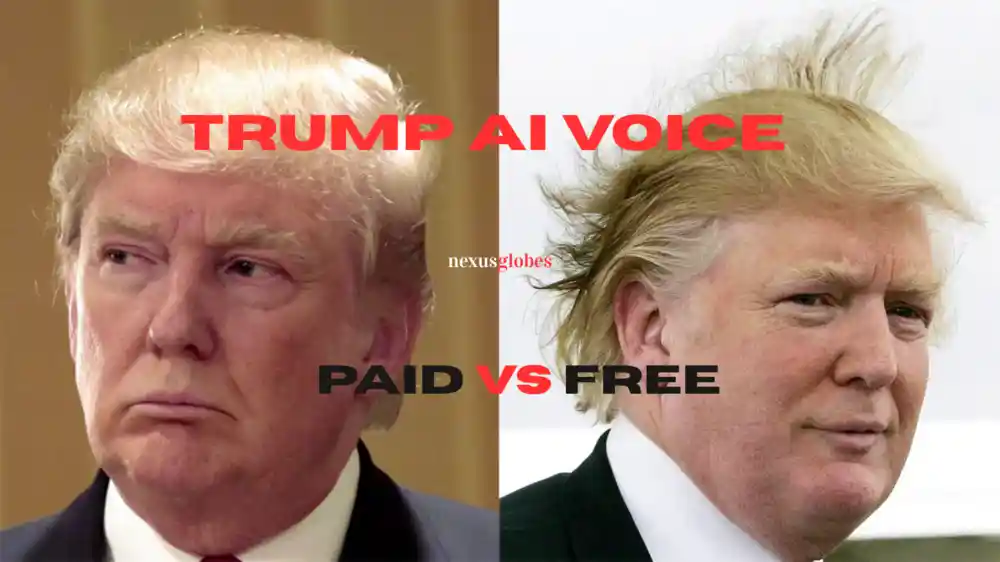
With the growing demand for Trump AI voice, many platforms now offer both free and paid versions. But which one is actually better? Here’s a breakdown of their differences:
1. Audio Quality Free vs. Paid
A free Donald Trump AI voice can generate decent results, but paid versions offer higher audio quality, more natural speech flow, and fewer distortions. If you need a professional grade Trump AI voice generator, a paid version is usually worth it.
2. Features & Customization
Most free AI Trump voice generators have limited voice settings you get a basic imitation with little control over tone, speed, or emotional delivery. Paid versions provide advanced controls, allowing users to fine-tune how Donald Trump’s AI voice sounds.
3. Availability & Usage Limits
Many free Donald Trump AI voice generators have usage caps, meaning you can only generate a small number of voice clips per day. Paid plans remove these restrictions, allowing unlimited use and faster processing.
4. Background Noise & Clarity
One major difference is audio clarity. Free versions may have robotic undertones or occasional glitches, while premium AI voice generators produce crystal-clear output that sounds nearly indistinguishable from a real recording.
5. Ethical & Legal Considerations
Some free AI Trump voice generators may not comply with ethical guidelines or security standards, while trusted paid platforms implement strict rules to prevent misuse. If you’re using Trump AI voice converters for content creation or business, a reputable paid service is a safer choice.
6. Which One Should You Choose?
- Go for free AI Trump voice tools if you’re experimenting, making casual content, or just having fun.
- Opt for a paid Trump AI voice generator if you need high-quality, professional voice replication with full customization and unlimited access.
What’s Next for AI Voice Technology?
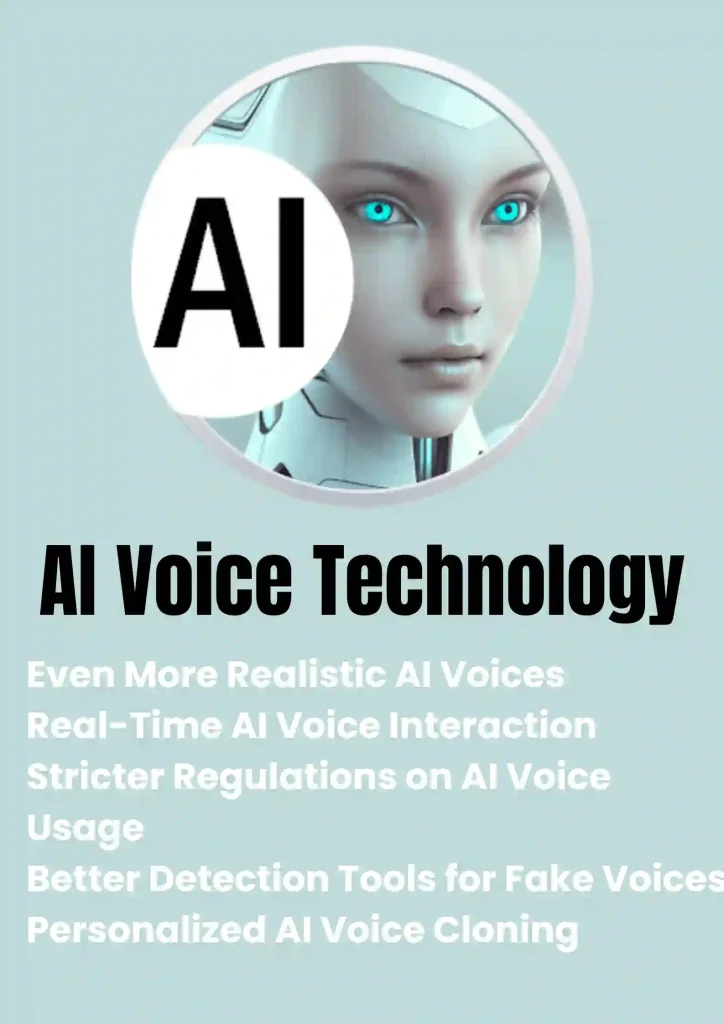
The future of Trump AI voice and AI-generated voices in general is evolving at an astonishing pace. What was once a novelty has now become a powerful tool for content creators, businesses, and even AI-driven assistants. As these systems continue to advance, the ability to mimic human speech with near-perfect accuracy is becoming a reality. In the coming years, AI-generated voices will likely become so realistic that distinguishing them from real human speech will be nearly impossible. This raises both exciting possibilities and serious challenges in fields like media, entertainment, and digital communication.
One of the biggest advancements on the horizon is the integration of real-time AI voice interaction. Instead of just converting text to speech, future Trump AI voice generators will be able to engage in live conversations, reacting dynamically to users just like a human would. Imagine a future where AI-powered political figures can hold real-time discussions, answer questions, or even give speeches based entirely on AI-generated responses. While this could revolutionize engagement and digital experiences, it also introduces concerns about misinformation, impersonation, and the potential for AI-driven propaganda.
1. Even More Realistic AI Voices
Future Trump AI voice generators will become almost indistinguishable from real speech, with improved emotional depth, natural pauses, and enhanced vocal expressions.
2. Real-Time AI Voice Interaction
AI voice generators will move beyond text-to-speech, allowing real-time conversation. Imagine having a live conversation with an AI-powered Donald Trump voice, responding dynamically to any topic.
3. Stricter Regulations on AI Voice Usage
With concerns over misinformation, fraud, and political manipulation, governments and tech companies will likely introduce laws to regulate AI-generated voices. Expect policies that require disclosure when AI voices are used in media or public messaging.
4. Better Detection Tools for Fake Voices
As AI Trump voice technology improves, so will voice detection software that helps identify AI-generated speech. This could help combat deepfakes and prevent misuse.
5. Personalized AI Voice Cloning
Soon, users may be able to create their own AI voice clones with the same level of realism as the Donald Trump AI voice generator, opening up possibilities for custom AI assistants, voiceovers, and digital personas.
The Power and Risks of Trump AI Voice
The rise of Trump AI voice technology is both exciting and concerning. It offers endless creative possibilities for content creators, comedians, and businesses but it also presents ethical dilemmas and potential risks.
✔ On the bright side, it fuels innovation, entertainment, and digital storytelling.
❌ On the other hand, it raises serious concerns about misinformation, deepfakes, and trust in digital media.
Moving forward, AI-generated voices will only become more realistic and accessible, making regulation, awareness, and ethical use more important than ever. The question isn’t whether AI voice technology will change the way we communicate it already has. The real question is: How will we handle this power responsibly?
Wanna learn more about AI Tools Check:
The Dangers of Deepfake Muke AI Undress Tools
What Purpose Do Fairness Measures Serve in AI Product Development?
Stay Tuned For more Updates on NEWS, HEALTH AND Tech&AI ON NEXUS GLOBES.
Follow OUR Quora Page.


